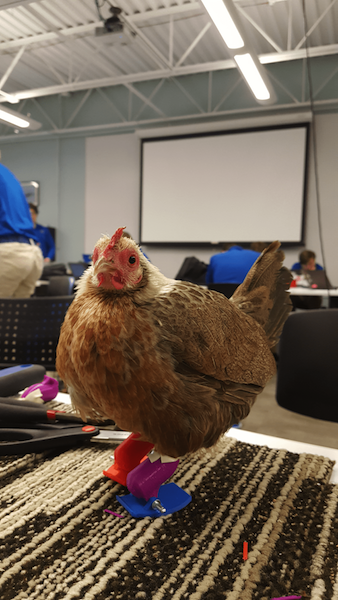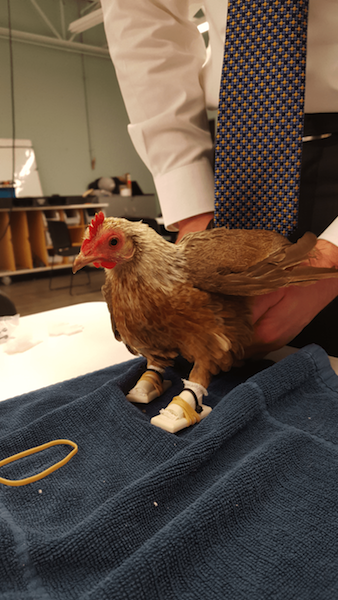When Debbie Harry — a chicken, not the Blondie singer — was being bullied by her fellow chickens, she chose to roost alone in her owner’s garage. Unfortunately, it happened to be a very cold winter’s night in Grand Rapids, Michigan.
Rachel Diepstra (Debbie’s owner who names all of her chickens after musicians) found the bird near-frozen to the floor. With it unclear whether she would survive, Diepstra was left with nothing to do but wrap “Debbie” in a towel and put her near a warm vent in the hope of saving her.
Luckily, the plucky bird survived the night, but lost both of her feet to frostbite. Diepstra said: “Her feet fell off.” But, she wasn’t going to give up on the chicken, she adds: “She’s my son’s favorite and we thought if we can give her a good quality of life . . . he hated the idea of Debbie not being around.”
Taking to social media to find someone who could help the chicken one way or another, Diepstra found the answer in Andrew Abissi. The husband of one of Diepstra’s high school friends, Abissi is an engineering and robotics teacher at West Michigan Aviation Academy. He decided to use help Debbie out while also using the experience as a learning opportunity for his students about real world applications of 3D modeling, prototyping and 3D printing.
“I proposed the problem to my students and students from other classes – bioengineering and CAD – and asked them to look for as many possible solution as we can to solve it,” Abissi explains.

3D Printing Prosthetic Chicken Feet for Extracurricular Credit
Initially, there were around a dozen students designing prototypes. However, eventually just three students remained to work on the prosthetics, James Brouckman, Peyton Ward and Ben McCallum.
Together, they designed thirty different prosthetics to help Debbie. “We started out trying to make feet that looked like chicken feet, but she couldn’t stand in those,” Abissi explained. “So then we tried to figure out what we could do better. One of the big problems with making them like chicken feet was they weren’t stable.”
After some 30 different design iterations, the student’s settled upon a winning prosthetic. Although Debbie learned to walk just fine without her feet, the new prosthetics offer more stability so she can roost, walk more comfortably and get around easily in winter.
Abissi explains that not only were the students able to learn about prototyping and 3D printing, they also learned patience, perseverance and compassion. He also adds that 3D printing can provide solutions which were previously impossible.
“It’s made prototyping incredibly easy. The fact that we could keep making new products, you couldn’t do that with injection molding… We have 15 printers so each student can keep working. It takes 30 minutes to print one. It makes the first steps a lot easier in the manufacturing process,” says Abissi.
Source: GR Mag

License: The text of "Students 3D Print Prosthetic Feet for “Debbie Harry” Chicken" by All3DP is licensed under a Creative Commons Attribution 4.0 International License.